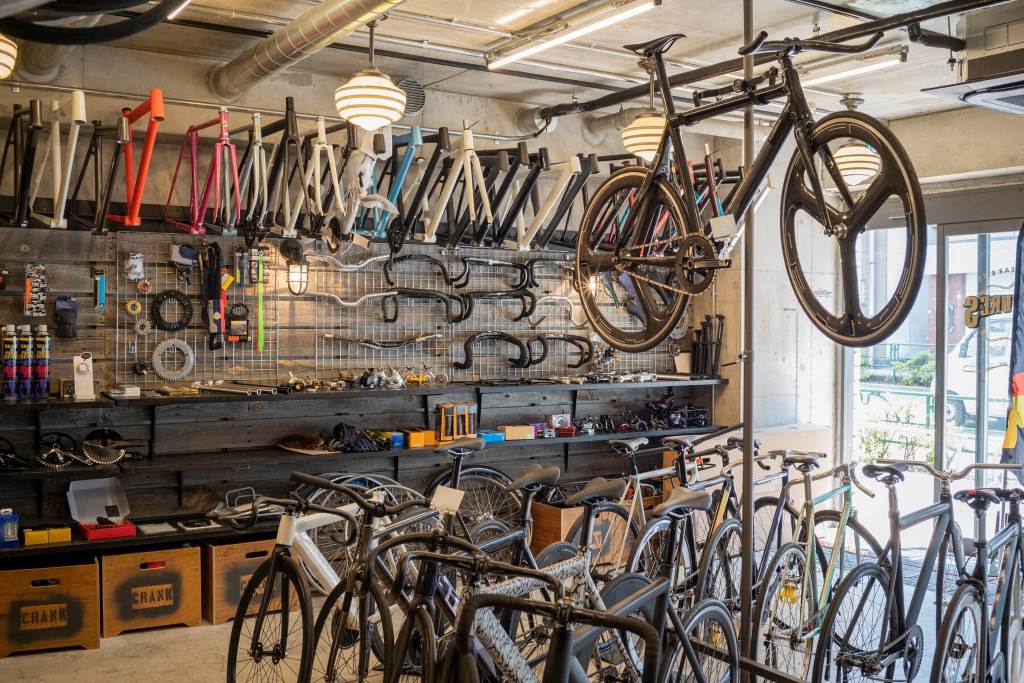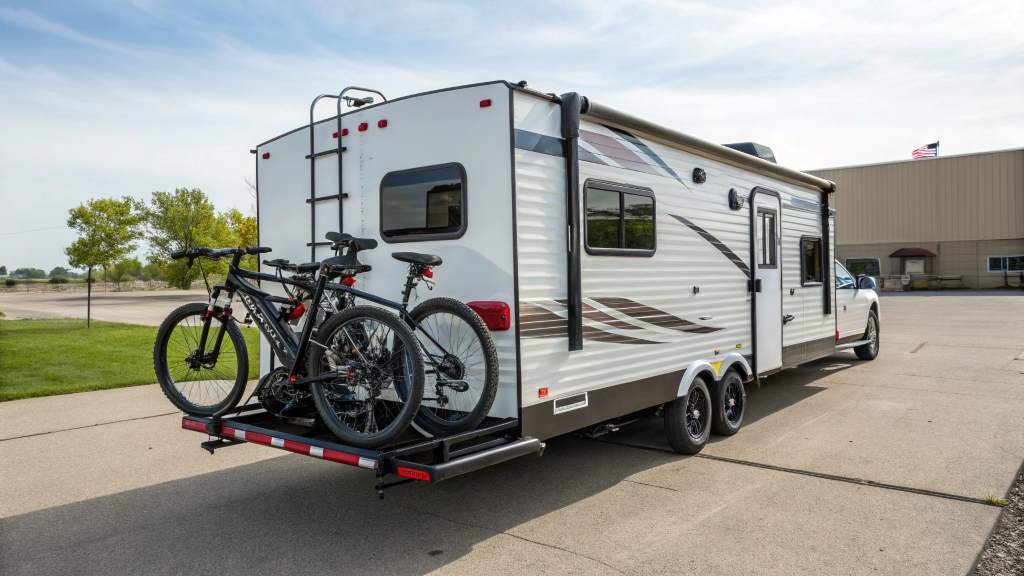The open road beckons, promising adventures and breathtaking landscapes. For many, the joy of travel is amplified by the freedom to explore on two wheels. Bringing your bicycles along on your travel trailer seems like a natural extension of this desire. However, the question of safety looms large: Is it truly safe to put a bike rack on a travel trailer?
This comprehensive guide delves into the intricacies of attaching bike racks to travel trailers, covering safety considerations, different rack types, installation procedures, and expert tips to ensure your cycling companions arrive at your destination unscathed.
Understanding the Challenges: Why Travel Trailers Pose Unique Concerns
Travel trailers are not your typical vehicles. They are designed for living, not necessarily for hauling heavy loads on their rear ends. Unlike cars or SUVs, travel trailers often have lightweight frames and rear bumpers that are not engineered to withstand the dynamic forces exerted by a loaded bike rack. These forces, including bouncing, swaying, and twisting, can lead to structural damage, compromised stability, and even hazardous situations on the road.
The primary concerns stem from:
- Frame Strength: Many travel trailer frames, especially lighter models, aren’t built to handle the added weight and stress of a bike rack and bicycles, potentially leading to frame damage or failure. Consider adding a rack-mounted rear bike light for extra visibility and safety on the road.
- Rear Bumper Integrity: The rear bumper of a travel trailer is often a thin, decorative piece, not a structural component. Attaching a bike rack directly to the bumper is a recipe for disaster, potentially leading to bumper detachment and lost bikes.
- Weight Distribution: Adding weight to the rear of a travel trailer can significantly alter its weight distribution, affecting its stability and handling. This can lead to trailer sway, reduced braking performance, and increased risk of accidents.
- Dynamic Forces: The constant motion of a travel trailer, especially on rough roads, creates substantial dynamic forces on the bike rack and its mounting points. This can cause fatigue, loosening, and eventual failure of the rack or its attachments.
- Visibility and Clearance: A bike rack and bicycles can obstruct rear visibility and reduce ground clearance, making it difficult to maneuver the trailer and increasing the risk of scraping or damage.

Choosing the Right Bike Rack: A Crucial First Step
Not all bike racks are created equal, and selecting the appropriate type is paramount for safety and peace of mind. Here’s a breakdown of the most common options:
- Frame-Mounted Bike Racks: These racks attach directly to the travel trailer’s frame, offering the most secure and stable solution. However, they require careful assessment of the frame’s strength and may necessitate professional installation. Frame mounted racks are usually the best solution.
- A-Frame Bike Racks: These racks mount on the A-frame of the trailer, the triangular structure at the front. They are a good option for trailers with limited rear frame strength. However, they can interfere with turning radius and may require modifications to the trailer’s front storage compartment.
- Receiver Hitch Bike Racks: If your travel trailer has a properly installed and rated receiver hitch, a hitch-mounted bike rack is a viable option. However, it’s crucial to ensure the hitch is rated for the combined weight of the rack and bicycles, as well as the dynamic forces involved. Many travel trailers do not have a receiver hitch rated for this type of load.
- Ladder-Mounted Bike Racks: Some manufacturers offer bike racks that attach to the ladder on the rear of the travel trailer. However, these racks are generally not recommended due to the limited weight capacity of most ladders and the potential for damage to the ladder and trailer wall.
- Roof Mounted Bike Racks: While effective for cars, roof mounted bike racks are generally impractical for travel trailers due to the height and difficulty of loading and unloading bicycles.
Prioritizing Safety: Essential Installation and Usage Tips
Even with the right bike rack, proper installation and usage are critical for ensuring safety. Here are some essential tips:
- Professional Installation: If you are unsure about your ability to properly install a bike rack, seek professional assistance from a qualified RV technician. They can assess your trailer’s frame, recommend the appropriate rack, and ensure a secure and safe installation.
- Frame Inspection: Before installing a frame-mounted rack, thoroughly inspect the trailer’s frame for any signs of damage or weakness. If you find any issues, consult a professional for repairs or reinforcement.
- Weight Distribution: Distribute the weight of the bicycles evenly across the rack and ensure the total weight does not exceed the rack’s capacity or the trailer’s frame rating.
- Secure Attachment: Use high-quality hardware and ensure all bolts and fasteners are tightened to the manufacturer’s specifications. Regularly check the rack and its attachments for any signs of loosening or damage.
- Safety Straps: Use safety straps to secure the bicycles to the rack and prevent them from swaying or bouncing during travel.
- Visibility and Clearance: Ensure the bike rack and bicycles do not obstruct rear visibility or reduce ground clearance. Install auxiliary lighting if necessary.
- Regular Inspections: Before each trip, thoroughly inspect the bike rack, its attachments, and the trailer’s frame for any signs of damage or wear.
- Reduce Speed: Driving at slower speeds can help minimize the dynamic forces on the bike rack and trailer.
- Check Local Laws: Be aware of any local laws or regulations regarding bike rack usage on travel trailers.
Addressing Specific Trailer Types:
- Lightweight Trailers: Extra caution is advised. Frame mounted options are best, and professional install is heavily suggested.
- Fifth Wheels: These generally have stronger frames than travel trailers, but weight distribution is still a concern.
- Toy Haulers: Toy haulers are designed to carry heavy loads, making them more suitable for bike racks. However, ensure the rack is compatible with the ramp door.
People Also Ask (FAQs):
Can I put a hitch-mounted bike rack on my travel trailer?
Yes, if your travel trailer has a properly installed and rated receiver hitch. However, most travel trailers do not have a receiver hitch rated for the dynamic loads that a bike rack generates.
Will a bike rack damage my travel trailer’s frame?
It can, especially if the rack is improperly installed or the frame is not strong enough. Frame mounted racks are the best option, but professional installation is highly recommended.
How much weight can my travel trailer’s rear bumper support?
Generally, very little. The rear bumper of a travel trailer is often a thin, decorative piece, not a structural component. Attaching a bike rack directly to the bumper is highly discouraged.
What is the safest way to carry bikes on a travel trailer?
A frame-mounted bike rack, professionally installed, is the safest option. Alternatively, carrying bikes inside the trailer or in the bed of a tow vehicle eliminates the risks associated with external racks.
Can I use a ladder-mounted bike rack on my travel trailer?
It is highly discouraged. The ladder is not designed for the weight and dynamic force created by a bike rack.
Does adding a bike rack affect my trailer’s warranty?
It could. Check with your trailer manufacturer or dealer for specific warranty information. Improper modifications can void warranties.
Conclusion: Balancing Adventure with Safety
Bringing your bicycles along on your travel trailer can enhance your outdoor adventures. However, it’s crucial to prioritize safety and choose the right bike rack and installation method. Frame-mounted racks, professionally installed, offer the most secure and stable solution. Thoroughly assess your trailer’s frame strength, distribute the weight evenly, and regularly inspect the rack and its attachments.
By following these guidelines, you can safely transport your bicycles and enjoy the freedom of exploring on two wheels, knowing you’ve taken the necessary precautions to protect your investment and ensure a safe and enjoyable journey. Always remember that safety should be the leading concern, and if there is any doubt, professional assistance is the best course of action.

Taylor is an outdoors & sports equipment specialist, sports author, bike traveler, bicycling and skating expert, and smoke-free ride activist. He is also a regular reviewer of outdoor sports gadgets and accessories. About safety gear and biking facts he analyzes and gives his feedback to outdoorxsports. Writes and tests to help him, you, and us.

